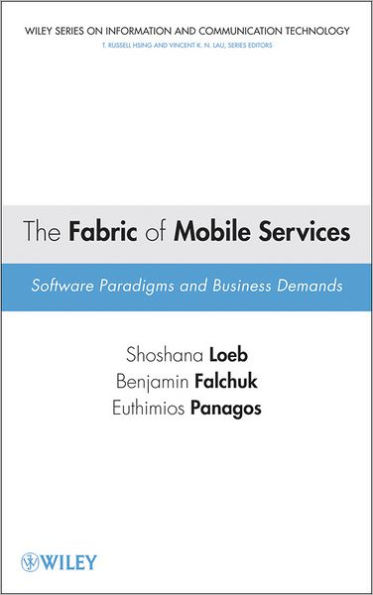Table of Contents
Preface xiii
1 Introduction 1
1.1 Introduction 1
1.2 Ubiquitous Computing and Next Generation Mobile Services 4
1.3 The Mobile Web 5
1.4 Emerging Mobile Services Environments - Network View 8
1.5 The Mobile Device Environment 11
1.6 The Personal Assistant Example 12
1.7 The Social Rules of Mobile Services 14
1.8 The Focus of This Book 16
2 The Business of Mobile Services 19
2.1 The Ecosystem and the Value Chain 22
2.2 Between Two Worlds 27
2.2.1 Cooperation vs. Competition 27
2.2.2 Dumb vs. Smart "Pipes" 29
2.2.3 Opposing Forces at the User Level 31
2.3 Innovative Business Models 31
2.3.1 The MVNOs 31
2.3.2 Communications as a Feature 33
2.3.3 The Economy of Free 34
2.4 Case Study: Personalized Navigation Devices 36
2.5 Summary 38
Questions 39
3 Mobile User Location as a Services Enabler 41
3.1 Introduction 42
3.2 LBSs-The Killer Enabler 44
3.2.1 LBSs and Wireless Operators 45
3.2.2 LBSs and Mass Market 46
3.3 Positioning Technology 48
3.3.1 Cellular 48
3.3.2 GPS and Assisted GPS 51
3.3.3 Wi-Fi Positioning 53
3.3.4 Short-Range Wireless Communications 54
3.3.5 Evaluating Positioning Technologies 58
3.4 LBS Architectures and Middleware 59
3.4.1 GIS Databases, Mapping, and Geo-coding 61
3.4.2 Location API for Java ME (JSR 179) 63
3.4.3 Charging 65
3.4.4 Subscriber Privacy and Profile Management 66
3.5 Information-Level Enablers 67
3.6 Summary 70
Questions 70
4 Simplicity and User Experience 71
4.1 New Services and User Experience 72
4.1.1 Hiding Complexity 75
4.1.2 Mobile User Expectations 78
4.1.3 Attention's "Long Tail" 80
4.2 User-Centered Simplicity and Experience 81
4.2.1 IllustratingUser-Centered Design Decisions and Principles 82
4.2.2 Complexity Issues Facing Both Users and Designers 84
4.2.3 Customizing and Identifying 85
4.2.4 Gadgets and Mashups - Building the Mobile Service Yourself! 88
4.3 Methodologies for Simplicity and User Experience 90
4.3.1 The Iterative Design Approach and Experience Prototyping 94
4.4 Case Studies: Simplifying Paradigms 95
4.4.1 Simplifying Access to the Network - NTT DoCoMo i-Mode 95
4.4.2 Simplifying Access to Third-Party Content - BREW and Get It Now® 96
4.4.3 Simplifying and Enabling Hands-Free - Voice XML 97
4.4.4 Simplifying the Form - Apple 98
4.4.5 Simplifying Search - Google 99
4.4.6 Simplifying Mobile Development - Web 2.0 and Mobile Mashups 99
4.5 Summary 101
Questions 102
5 The Always-on Infrastructure Challenge 103
5.1 Always-on Service Properties 104
5.1.1 Interactive Processing 106
5.1.2 High Availability 107
5.1.3 Scalability 108
5.1.4 Circuit/Packet Infrastructure Considerations 111
5.2 Architecting for Always-on Mobile Services 112
5.2.1 Scalable Mobile Services and Event-Driven Architectures 112
5.2.2 High Availability for Mobile Services 118
5.2.3 Always-on System Architecture Considerations 120
5.2.4 Virtualization 123
5.3 Business Impact of Always-on 125
5.3.1 User Expectations 125
5.3.2 Partnerships and Business Agreements 126
5.3.3 Over/Under Engineering 128
5.4 Data Management 129
5.4.1 Modeling Location Information 129
5.4.2 Accessing Location Information 130
5.4.3 Partioning 131
5.4.4 Replication 131
5.5 Summary 133
Questions 133
6 Underpinnings of Mobile Opportunism 135
6.1 Managing Complexity and Opportunities 135
6.1.1 Opportunism 137
6.1.2 Opportunism and Service Design 141
6.2 Technologies Supporting Opportunism 153
6.2.1 Agent-Based Systems 153
6.2.2 Semantic Web and Ontology 156
6.3 Design of Opportunistic Systems - Examples 158
6.3.1 Opportunistic Network Utilization for Mobile Devices 158
6.3.2 Opportunistic Navigation and Reminder Systems 161
6.3.3 Mobile Dating Systems 163
6.3.4 Mobile Localized Information Sharing 164
6.4 Relevant Standards 166
6.5 Summary 167
Questions 167
7 Design Patterns for Mobile Services 169
7.1 Background 170
7.2 Architectural Patterns 170
7.2.1 Model-View-Controller 171
7.2.2 Client-Server 172
7.2.3 Minimalistic Core 174
7.3 User Interface Design 175
7.3.1 Wizards 176
7.3.2 Slideshows 177
7.3.3 Pagination 178
7.3.4 Cascading Menus 179
7.3.5 Mobile Widget Visual Patterns 180
7.3.6 Voice Interface 181
7.4 Distribution and Resource Management 183
7.4.1 Remote Proxy 183
7.4.2 Data Transfer Object 184
7.4.3 Remote Fa&ccidle;ade 185
7.4.4 Caching 186
7.4.5 Pre-Fetching 186
7.4.6 Synchronization 187
7.5 Event Notification 189
7.5.1 OMG Notification Service 190
7.6 Use Case: Voice-Based Content Management 191
7.6.1 Voice Application Development Life-Cycle 192
7.6.2 Why Voice Authoring? 194
7.6.3 Information Model 194
7.6.4 System Architecture 196
7.7 Summary 198
Questions 198
8 Advanced Services of Today and Tomorrow 199
8.1 Emerging Mobile Application Areas 200
8.1.1 Reminder Systems 201
8.1.2 Automotive Telematics 203
8.1.3 Mobile Healthcare Trends 205
8.1.4 Mobile Marketing 207
8.1.5 Mobile Virtual Worlds 209
8.2 Advanced and Emerging Mobile Technologies and Services 211
8.2.1 Auctioning Models Based on User Context 212
8.2.2 Repurposing the Mobile Device 213
8.2.3 Ambient Services and Interactions 216
8.2.4 Google Top 50 Android Applications 218
8.2.5 Mobile Augmented Reality 220
8.2.6 Lifestreaming 222
8.2.7 Evolution of the Device: Smart and Organic 222
8.2.8 Mobile Barcodes 224
8.3 Getting Personal - What It Takes and Why It's Important 225
8.3.1 Challenges of Personalized Mobile Services 227
8.4 Summary 229
Questions 230
9 Concluding Remarks 231
References 233
Index 241



